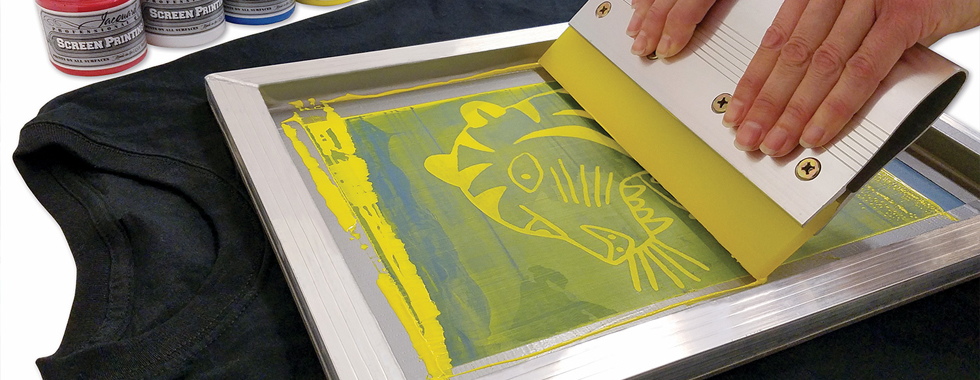ChatGPT said: 10:9 Design Company FAQs: answers to your top questions about their services
The Crucial Overview to Comprehending Screen Printing and Its Versatile Uses
Screen printing has an abundant history that dates back to old times, evolving right into a sophisticated method made use of across numerous sectors today. This guide explores the intricacies of the screen printing process, detailing its applications in advertising, fashion, and home style - 10:9 Design Texas. Understanding these fundamentals can open innovative capacity for both business and creative projects. The adhering to areas will certainly reveal important ideas and techniques to enhance one's screen printing ventures
The Background of Screen Printing
Screen printing has roots that trace back centuries, its development mirrors the artistic and technological improvements of various cultures. Coming from old China, the strategy was originally used for decorating textiles and later infect Japan, where it came to be integral to Ukiyo-e woodblock printing. The method shifted to Europe in the 18th century, where it gained popularity among craftsmens and business printers. The invention of photo solution in the 20th century revolutionized screen printing, allowing for more intricate styles and higher effectiveness. Musicians like Andy Warhol additionally drove its appeal, utilizing the medium to produce famous works that blended commercialism and great art. By the late 20th century, screen printing had developed itself as a flexible technique, employed in fashion, advertising, and great art. Today, it proceeds to advance, incorporating digital innovation and broadening its applications across various sectors.
The Screen Printing Process Explained
Screen printing changes artistic visions into substantial designs via a collection of exact steps. A picture is developed and then transferred onto a screen, commonly made of great mesh textile stretched over a frame. A light-sensitive solution is put on the screen, which is revealed to light, solidifying in locations not covered by the photo. After rinsing the unhardened emulsion, a pattern is formed.
Next, the screen is positioned over the substratum, whether it be material, paper, or one more material. Ink is after that pushed via the open areas of the stencil using a squeegee, depositing the layout onto the substratum listed below. This process can be duplicated for several colors, requiring separate displays for each and every shade. Ultimately, the printed thing is treated using heat to ensure the ink adheres correctly, leading to a long lasting, vibrant design prepared for usage.
Sorts Of Screen Printing Techniques

In addition, specialized methods, such as discharge screen printing, remove color from the fabric to create softer prints, while foil screen printing applies metal aluminum foil to attain a shiny coating (10:9 Design Abilene). Each technique supplies distinctive characteristics, accommodating different imaginative requirements and production ranges, eventually expanding the opportunities within the screen printing domain name
Applications of Screen Printing in Different Industries

Additionally, the signage and advertising and marketing markets utilize screen printing for producing distinctive screens and banners. This approach enables for bold colors and intricate styles that capture focus. In electronic devices, screen printing is utilized for using conductive inks to circuit boards, crucial for component links. The home decoration industry accepts screen printing to generate distinctive styles on fabrics and wall art. Generally, screen printing acts as a crucial tool across varied fields, improving items with personalized and visually enticing graphics.
Tips for Successful Screen Printing Projects
While carrying out a screen printing project, mindful focus to detail can significantly boost the final end result. Initially, picking high-quality materials is essential; this consists of more information the screen, inks, and substrates. Utilizing appropriate mesh matters can influence ink deposition and detail visit this web-site resolution. Prep work is similarly essential; extensive cleansing of displays and appropriate exposure times guarantee crisp prints.
Next off, precise registration is essential for multi-color prints. Using alignment tools can aid achieve precise layering. Additionally, testing prints on scrap products before manufacturing assists recognize potential concerns without squandering sources.

Frequently Asked Concerns
What Materials Are Best for Screen Printing on Fabric?
Cotton and polyester blends are perfect for screen printing on material because of their toughness and ink absorption. In addition, specialized textiles like silk or canvas can produce one-of-a-kind structures and finishes, enhancing the general design high quality.
How Do I Clean and Maintain Screen Printing Devices?
To keep and cleanse screen printing devices, one must consistently clean displays with suitable solvents, examine squeegees for wear, oil relocating components, and store all items in a dry, dust-free atmosphere to prolong their lifespan.
What Are the Ecological Influences of Screen Printing?
Screen printing can have significant ecological influences, including chemical waste from inks and solvents, water usage throughout cleaning processes, and power usage. Sustainable practices and eco-friendly products are vital for reducing these adverse impacts.
Can Screen Printing Be Done at Home Properly?
Screen printing can be successfully done at home with the right products and techniques. Enthusiasts can produce high quality prints, though success depends on their ability level, devices, and understanding of the process included.
What Are the Prices Related To Beginning a Screen Printing Business?

Beginning a screen printing organization involves expenses for tools, products, and workspace. Preliminary expenses usually vary from a couple of hundred to several thousand dollars, depending upon the range, top quality of machinery, and preferred manufacturing capacity.
Screen printing has a rich history that dates back to old times, progressing read the full info here into a sophisticated technique utilized across different sectors today. An additional technique, rotary screen printing, employs round displays, helping with constant printing on material rolls, consequently boosting performance for large manufacturings. Additionally, specialty methods, such as discharge screen printing, eliminate dye from the material to produce softer prints, while foil screen printing applies metallic foil to accomplish a shiny surface. In the fashion industry, screen printing is widely used to create vibrant layouts on garments, enabling brands to display their one-of-a-kind designs. Cotton and polyester blends are excellent for screen printing on textile due to their durability and ink absorption.